HP G72-B66US User Manual
Notebook PC User Guide
© Copyright 2010 Hewlett-Packard
Development Company, L.P.
Bluetooth is a trademark owned by its proprietor and used by Hewlett-Packard Company under license. Microsoft and Windows are U.S. registered trademarks of Microsoft Corporation. SD Logo is a trademark of its proprietor.
The information contained herein is subject to change without notice. The only warranties for HP products and services are set forth in the express warranty statements accompanying such products and services. Nothing herein should be construed as constituting an additional warranty. HP shall not be liable for technical or editorial errors or omissions contained herein.
First Edition: April 2010
Document Part Number: 616711-001
Product notice
This user guide describes features that are common to most models. Some features may not be available on your computer.

Safety warning notice
WARNING! To reduce the possibility of heat-related injuries or of overheating the computer, do not place the computer directly on your lap or obstruct the computer air vents. Use the computer only on a hard, flat surface. Do not allow another hard surface, such as an adjoining optional printer, or a soft surface, such as pillows or rugs or clothing, to block airflow. Also, do not allow the AC adapter to contact the skin or a soft surface, such as pillows or rugs or clothing, during operation. The computer and the AC adapter comply with the user-accessible surface temperature limits defined by the International Standard for Safety of Information Technology Equipment (IEC 60950).
iii
iv Safety warning notice

Table of contents
1 Features |
|
Identifying hardware ............................................................................................................................. |
1 |
Components ......................................................................................................................................... |
2 |
Top components .................................................................................................................. |
2 |
TouchPad ............................................................................................................ |
2 |
Lights ................................................................................................................... |
3 |
Button and speakers ........................................................................................... |
4 |
Keys .................................................................................................................... |
5 |
Right-side components ........................................................................................................ |
6 |
Left-side components .......................................................................................................... |
7 |
Bottom components ............................................................................................................. |
8 |
Display components ............................................................................................................ |
9 |
Wireless antennas ............................................................................................................... |
9 |
Additional hardware components ...................................................................................... |
11 |
Labels ................................................................................................................................................. |
12 |
2 Wireless, local area network, and modem |
|
Using wireless devices ....................................................................................................................... |
13 |
Identifying wireless and network status icons .................................................................... |
14 |
Using the wireless controls ................................................................................................ |
14 |
Using the wireless action key ............................................................................................ |
14 |
Using HP Wireless Assistant ............................................................................................. |
15 |
Using operating system controls ........................................................................................ |
15 |
Using a WLAN .................................................................................................................................... |
16 |
Setting up a WLAN ............................................................................................................ |
16 |
Protecting your WLAN ....................................................................................................... |
17 |
Connecting to a WLAN ...................................................................................................... |
18 |
Roaming to another network .............................................................................................. |
18 |
Using Bluetooth wireless devices (select models only) ...................................................................... |
19 |
Bluetooth and Internet Connection Sharing (ICS) ............................................................. |
19 |
Troubleshooting wireless connection problems ................................................................................. |
20 |
Cannot connect to a WLAN ............................................................................................... |
20 |
Cannot connect to a preferred network ............................................................................. |
20 |
Network icon is not displayed ............................................................................................ |
21 |
v
Current network security codes are unavailable ................................................................ |
21 |
WLAN connection is very weak ......................................................................................... |
22 |
Cannot connect to the wireless router ............................................................................... |
22 |
Using the modem (select models only) .............................................................................................. |
23 |
Connecting a modem cable ............................................................................................... |
23 |
Connecting a country-specific modem cable adapter ........................................................ |
24 |
Selecting a location setting ................................................................................................ |
24 |
Viewing the current location selection ............................................................... |
24 |
Adding new locations when traveling ................................................................ |
25 |
Solving travel connection problems .................................................................. |
26 |
Connecting to a local area network .................................................................................................... |
27 |
3 Pointing devices and keyboard |
|
Using the TouchPad ........................................................................................................................... |
28 |
Turning the TouchPad on and off ....................................................................................................... |
29 |
Using TouchPad gestures .................................................................................................................. |
29 |
Scrolling .............................................................................................................................................. |
30 |
Pinching ............................................................................................................................................. |
30 |
Rotating .............................................................................................................................................. |
31 |
Setting pointing device preferences ................................................................................................... |
31 |
Using the keyboard ............................................................................................................................ |
31 |
Cleaning the TouchPad and keyboard ............................................................................................... |
34 |
4 Multimedia |
|
Multimedia features ............................................................................................................................ |
35 |
Identifying your multimedia components ........................................................................... |
36 |
Adjusting the volume ......................................................................................................... |
37 |
Using the media activity functions ..................................................................................... |
38 |
Using the media activity action keys ................................................................. |
38 |
Multimedia software ........................................................................................................................... |
39 |
Using CyberLink PowerDVD software ............................................................................... |
39 |
Using other preinstalled multimedia software .................................................................... |
39 |
Installing multimedia software from a disc ......................................................................... |
39 |
Audio .................................................................................................................................................. |
40 |
Connecting external audio devices .................................................................................... |
40 |
Checking your audio functions ........................................................................................... |
40 |
Video .................................................................................................................................................. |
41 |
Connecting an HDMI device (select models only) ............................................................. |
42 |
Configuring audio for HDMI (select models only) .............................................. |
43 |
Optical drive ....................................................................................................................................... |
44 |
Webcam (select models only) ............................................................................................................ |
45 |
Webcam tips ...................................................................................................................... |
45 |
Adjusting webcam properties ............................................................................................. |
45 |
vi
5 Power management |
|
Setting power options ......................................................................................................................... |
47 |
Using power-saving states ................................................................................................. |
47 |
Initiating and exiting Sleep ................................................................................ |
48 |
Initiating and exiting Hibernation ....................................................................... |
48 |
Using the battery meter ..................................................................................................... |
49 |
Using power plans ............................................................................................................. |
49 |
Viewing the current power plan ......................................................................... |
49 |
Selecting a different power plan ........................................................................ |
49 |
Customizing power plans .................................................................................. |
49 |
Setting password protection on wakeup ............................................................................ |
50 |
Using external AC power .................................................................................................................... |
51 |
Connecting the AC adapter ............................................................................................... |
52 |
Testing an AC adapter ....................................................................................................... |
53 |
Using battery power ........................................................................................................................... |
54 |
Finding battery information in Help and Support ............................................................... |
54 |
Using Battery Check .......................................................................................................... |
54 |
Displaying the remaining battery charge ........................................................................... |
55 |
Inserting or removing the battery ....................................................................................... |
55 |
Charging a battery ............................................................................................................. |
56 |
Maximizing battery discharge time .................................................................................... |
57 |
Managing low battery levels .............................................................................................. |
57 |
Identifying low battery levels ............................................................................. |
57 |
Resolving a low battery level ............................................................................. |
58 |
Resolving a low battery level when external power is available ....... |
58 |
Resolving a low battery level when a charged battery is |
|
available ........................................................................................... |
58 |
Resolving a low battery level when no power source is |
|
available ........................................................................................... |
58 |
Resolving a low battery level when the computer cannot exit |
|
Hibernation ....................................................................................... |
58 |
Calibrating a battery ........................................................................................................... |
58 |
Step 1: Fully charge the battery ........................................................................ |
58 |
Step 2: Disable Hibernation and Sleep ............................................................. |
59 |
Step 3: Discharge the battery ............................................................................ |
60 |
Step 4: Fully recharge the battery ..................................................................... |
60 |
Step 5: Reenable Hibernation and Sleep .......................................................... |
61 |
Conserving battery power .................................................................................................. |
61 |
Storing a battery ................................................................................................................ |
61 |
Disposing of a used battery ............................................................................................... |
62 |
Replacing the battery ......................................................................................................... |
62 |
Switching between graphics modes (select models only) .................................................................. |
63 |
Shutting down the computer ............................................................................................................... |
64 |
vii
6 Drives |
|
Handling drives ................................................................................................................................... |
65 |
Optical drive ....................................................................................................................................... |
66 |
Identifying the installed optical drive .................................................................................. |
66 |
Using optical discs ............................................................................................................. |
67 |
Selecting the right disc (CDs, DVDs, and BDs) ................................................................. |
68 |
CD-R discs ........................................................................................................ |
68 |
CD-RW discs ..................................................................................................... |
68 |
DVD±R discs ..................................................................................................... |
68 |
DVD±RW discs ................................................................................................. |
68 |
LightScribe DVD+R discs .................................................................................. |
69 |
Blu-ray Disc (BD) .............................................................................................. |
69 |
Playing a CD, DVD, or BD ................................................................................................. |
69 |
Configuring AutoPlay ......................................................................................................... |
71 |
Changing DVD region settings .......................................................................................... |
71 |
Observing the copyright warning ....................................................................................... |
72 |
Copying a CD, DVD, or BD ................................................................................................ |
72 |
Creating or “burning” a CD or DVD .................................................................................... |
73 |
Removing a CD, DVD, or BD ............................................................................................. |
74 |
Troubleshooting drive and device driver problems ............................................................................. |
74 |
The optical disc tray does not open for removal of a CD, DVD, or BD .............................. |
74 |
A disc does not play automatically ..................................................................................... |
75 |
A DVD movie stops, skips, or plays erratically .................................................................. |
75 |
A DVD movie is not visible on an external display ............................................................. |
76 |
The process of burning a disc does not begin, or it stops before completion .................... |
76 |
A DVD playing in Windows Media Player produces no sound or display .......................... |
76 |
A device driver must be reinstalled .................................................................................... |
76 |
Obtaining the latest HP device drivers .............................................................. |
77 |
Obtaining the latest Windows device drivers .................................................... |
78 |
Using external drives .......................................................................................................................... |
79 |
Improving hard drive performance ..................................................................................................... |
80 |
Using Disk Defragmenter ................................................................................................... |
80 |
Using Disk Cleanup ........................................................................................................... |
80 |
Replacing the hard drive .................................................................................................................... |
81 |
7 External devices and external media cards |
|
Using a USB device ........................................................................................................................... |
85 |
Connecting a USB device .................................................................................................. |
85 |
Removing a USB device .................................................................................................... |
86 |
Using Digital Media Slot cards ........................................................................................................... |
87 |
Inserting a digital card ........................................................................................................ |
87 |
Removing a digital card ..................................................................................................... |
88 |
viii
8 Adding or replacing a memory module |
|
9 Security |
|
Protecting the computer ..................................................................................................................... |
92 |
Using passwords ................................................................................................................................ |
93 |
Setting passwords in Windows .......................................................................................... |
93 |
Setting passwords in Setup Utility ..................................................................................... |
93 |
Administrator password ..................................................................................... |
94 |
Managing an administrator password ............................................... |
94 |
Entering an administrator password ................................................. |
94 |
Power-on password .......................................................................................... |
95 |
Managing a power-on password ...................................................... |
95 |
Entering a power-on password ......................................................... |
95 |
Using antivirus software ..................................................................................................................... |
96 |
Using firewall software ....................................................................................................................... |
96 |
Installing critical security updates ....................................................................................................... |
97 |
Installing an optional security cable .................................................................................................... |
97 |
Appendix A Setup Utility (BIOS) |
|
Starting Setup Utility ........................................................................................................................... |
98 |
Using Setup Utility .............................................................................................................................. |
99 |
Changing the language of Setup Utility ............................................................................. |
99 |
Navigating and selecting in Setup Utility ............................................................................ |
99 |
Displaying system information ......................................................................................... |
100 |
Restoring default settings in Setup Utility ........................................................................ |
100 |
Exiting Setup Utility .......................................................................................................... |
101 |
Setup Utility menus .......................................................................................................................... |
101 |
Main menu ....................................................................................................................... |
101 |
Security menu .................................................................................................................. |
101 |
System Configuration menu ............................................................................................ |
102 |
Diagnostics menu ............................................................................................................ |
102 |
Appendix B Software updates |
|
Updating the BIOS ........................................................................................................................... |
104 |
Determining the BIOS version ......................................................................................... |
104 |
Downloading a BIOS update ........................................................................................... |
105 |
Updating programs and drivers ........................................................................................................ |
106 |
Appendix C Backup and recovery |
|
Creating recovery discs .................................................................................................................... |
108 |
Backing up your information ............................................................................................................. |
109 |
Using Windows Backup and Restore .............................................................................. |
110 |
Using system restore points ............................................................................................ |
111 |
ix
When to create restore points ......................................................................... |
111 |
Create a system restore point ......................................................................... |
111 |
Restore to a previous date and time ............................................................... |
111 |
Performing a recovery ...................................................................................................................... |
112 |
Recovering from the recovery discs ................................................................................ |
112 |
Recovering from the dedicated recovery partition (select models only) .......................... |
112 |
Index ................................................................................................................................................................. |
113 |
x

1 Features
Identifying hardware
To see a list of hardware installed in the computer:
▲Select Start > Control Panel > System and Security. Then in the System area, click Device Manager.
You can also add hardware or modify device configurations using Device Manager.
 NOTE: Windows® includes the User Account Control feature to improve the security of your computer. You may be prompted for your permission or password for tasks such as installing software, running utilities, or changing Windows settings. See Help and Support for more information.
NOTE: Windows® includes the User Account Control feature to improve the security of your computer. You may be prompted for your permission or password for tasks such as installing software, running utilities, or changing Windows settings. See Help and Support for more information.
Identifying hardware |
1 |

Components
Top components
TouchPad
Component |
Description |
|
|
|
|
(1) |
TouchPad off indicator |
● When the TouchPad zone is active, the light is off. |
|
|
● When the TouchPad zone is inactive, the light is amber. |
|
|
● To switch between active and inactive, quickly double-tap the |
|
|
TouchPad off indicator. |
|
|
|
(2) |
TouchPad zone |
Moves the pointer and selects or activates items on the screen. |
|
|
|
(3) |
Left TouchPad control |
Use the left side of the TouchPad control button like the left button |
|
|
on an external mouse. |
|
|
|
(4) |
Right TouchPad control |
Use the right side of the TouchPad control button like the right |
|
|
button on an external mouse. |
|
|
|
There is an unmarked scroll zone inside the right edge of the TouchPad. To scroll up and down using the TouchPad vertical scroll zone, slide your finger up or down along the right edge of the TouchPad.
For more information about TouchPad features, see Using the TouchPad on page 28.
2 Chapter 1 Features
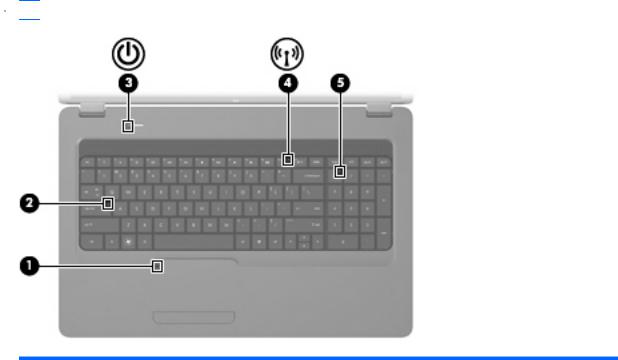
Lights
 NOTE: Your computer may look slightly different from the illustration in this section.
NOTE: Your computer may look slightly different from the illustration in this section.
Component |
Description |
|
|
|
|
(1) |
TouchPad light |
● Off: TouchPad is enabled. |
|
|
● Amber: TouchPad is disabled. |
|
|
To switch the Touchpad on and off, quickly double-tap the |
|
|
Touchpad light. |
|
|
|
(2) |
Caps lock light |
On: Caps lock is on. |
|
|
|
(3) |
Power light |
● On: The computer is on. |
|
|
● Blinking: The computer is in the Sleep state. |
|
|
● Off: The computer is off or in Hibernation. |
|
|
|
(4) |
Wireless light |
● White: An integrated wireless device, such as a wireless local |
|
|
area network (WLAN) device and/or a Bluetooth® device, is |
|
|
on. |
|
|
● Amber: All wireless devices are off. |
|
|
|
(5) |
num lk light |
On: The numeric function of the keypad is enabled. |
|
|
Off: The navigation function of the keypad is enabled. |
|
|
|
Components 3
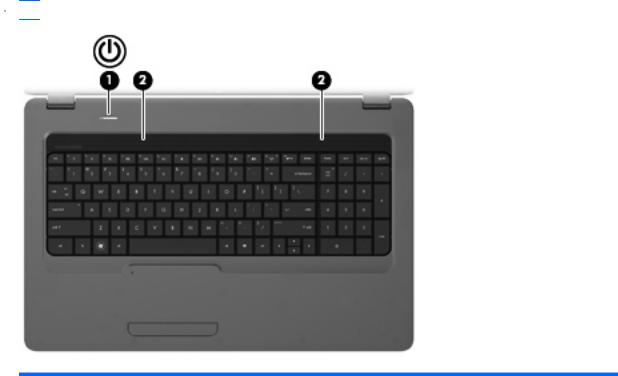
Button and speakers
 NOTE: Your computer may look slightly different from the illustration in this section.
NOTE: Your computer may look slightly different from the illustration in this section.
Component |
Description |
|
|
|
|
(1) |
Power button |
● When the computer is off, press the button to turn on the |
|
|
computer. |
|
|
● When the computer is on, press the button briefly to initiate |
|
|
Sleep. |
|
|
● When the computer is in the Sleep state, press the button |
|
|
briefly to exit Sleep. |
|
|
● When the computer is in Hibernation, press the button briefly |
|
|
to exit Hibernation. |
|
|
If the computer has stopped responding and Windows shutdown |
|
|
procedures are ineffective, press and hold the power button for at |
|
|
least 5 seconds to turn off the computer. |
|
|
To learn more about your power settings, select Start > Control |
|
|
Panel > System and Security > Power Options. |
|
|
|
(2) |
Speakers (2) |
Produce sound. |
|
|
|
4 Chapter 1 Features

Keys
 NOTE: Your computer may look slightly different from the illustration in this section.
NOTE: Your computer may look slightly different from the illustration in this section.
Component |
Description |
|
|
|
|
(1) |
esc key |
Displays system information when pressed in combination with the |
|
|
fn key. |
|
|
|
(2) |
fn key |
Displays system information when pressed in combination with the |
|
|
esc key. |
|
|
|
(3) |
Windows logo key |
Displays the Windows Start menu. |
|
|
|
(4) |
Windows applications key |
Displays a shortcut menu for items beneath the pointer. |
|
|
|
(5) |
Integrated numeric keypad keys |
Can be used like the keys on an external numeric keypad. |
|
|
|
(6) |
Action keys |
Execute frequently used system actions. |
|
|
|
For more information about using action keys, see Using the keyboard on page 31.
Components 5

Right-side components
 NOTE: Your computer may look slightly different from the illustration in this section.
NOTE: Your computer may look slightly different from the illustration in this section.
Component |
Description |
|
|
|
|
(1) |
Optical drive |
Reads optical discs and, on select models, also writes to optical |
|
|
discs. |
|
|
|
(2) |
Optical drive light on release button |
Blinking: The optical drive is being accessed. |
|
|
|
(3) |
USB port |
Connects an optional USB device. |
|
|
|
(4) |
RJ-11 (modem) jack (select models only) |
Connects a modem cable (purchased separately). |
|
|
|
(5) |
AC adapter light |
● Blinking white: The computer is in the Sleep state. |
|
|
● On white: The computer is connected to external power. |
|
|
● Amber: The battery is charging. |
|
|
● Off: The computer is not connected to external power. |
|
|
|
(6) |
Power connector |
Connects an AC adapter. |
|
|
|
(7) |
Security cable slot |
Attaches an optional security cable to the computer. |
|
|
NOTE: The security cable is designed to act as a deterrent, but |
|
|
it may not prevent the computer from being mishandled or stolen. |
|
|
|
6 Chapter 1 Features
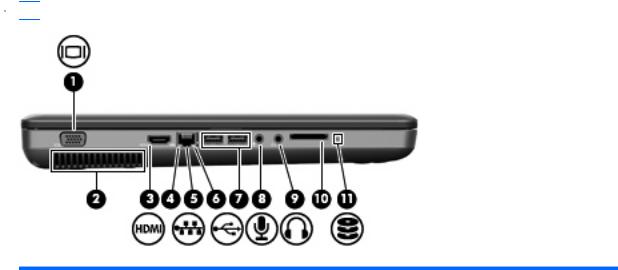
Left-side components
 NOTE: Your computer may look slightly different from the illustration in this section.
NOTE: Your computer may look slightly different from the illustration in this section.
Component |
Description |
||
|
|
|
|
(1) |
External monitor port |
Connects an external VGA monitor or projector. |
|
|
|
|
|
(2) |
Vent |
Enables airflow to cool internal components. |
|
|
|
NOTE: The computer fan starts up automatically to cool internal |
|
|
|
components and prevent overheating. It is normal for the internal |
|
|
|
fan to cycle on and off during routine operation. |
|
|
|
|
|
(3) |
HDMI port (select models only) |
Connects an optional video or audio device, such as a high- |
|
|
|
definition television, or any compatible digital or audio component. |
|
|
|
|
|
(4) |
Network connection light |
White: The computer is connected to the network. |
|
|
|
|
|
(5) |
RJ-45 (network) jack |
Connects a network cable. |
|
|
|
|
|
(6) |
Network activity light |
Amber: Data is being transmitted over the network. |
|
|
|
|
|
(7) |
USB ports (2) |
Connect optional USB devices. |
|
|
|
|
|
(8) |
Audio-in (microphone) jack |
Connects an optional computer headset microphone, stereo array |
|
|
|
microphone, or monaural microphone. |
|
|
|
|
|
(9) |
Audio-out (headphone) jack |
Produces sound when connected to optional powered stereo |
|
|
|
speakers, headphones, earbuds, a headset, or television audio. |
|
|
|
|
|
(10) |
Digital Media Slot (select models only) |
Supports the following optional digital card formats: |
|
|
|
● |
Memory Stick (MS) |
|
|
● |
Memory Stick Pro (MSP) |
|
|
● |
MultiMediaCard (MMC) |
|
|
● |
Secure Digital (SD) Memory Card |
|
|
● |
xD-Picture Card (XD) |
|
|
|
|
(11) |
Drive light |
On: The hard drive is in use. |
|
|
|
|
|
Components 7
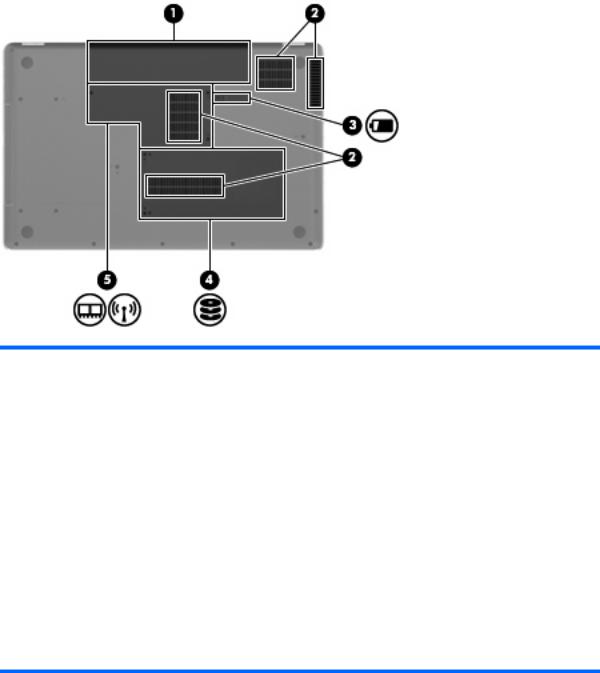
Bottom components
Component |
Description |
|
|
|
|
(1) |
Battery bay |
Holds the battery. |
|
|
|
(2) |
Vents (4) |
Enable airflow to cool internal components. |
|
|
NOTE: The computer fan starts up automatically to cool internal |
|
|
components and prevent overheating. It is normal for the internal |
|
|
fan to cycle on and off during routine operation. |
|
|
|
(3) |
Battery release latch |
Releases the battery from the battery bay. |
|
|
|
(4) |
Hard drive bay |
Holds the hard drive. |
|
|
|
(5) |
Memory module compartment |
Holds two memory modules, the wireless local area network |
|
|
(WLAN) module, and the RTC battery. |
CAUTION: To prevent an unresponsive system, replace the wireless module only with a wireless module authorized for use in the computer by the governmental agency that regulates wireless devices in your country or region. If you replace the module and then receive a warning message, remove the module to restore computer functionality, and then contact technical support through Help and Support.
8 Chapter 1 Features
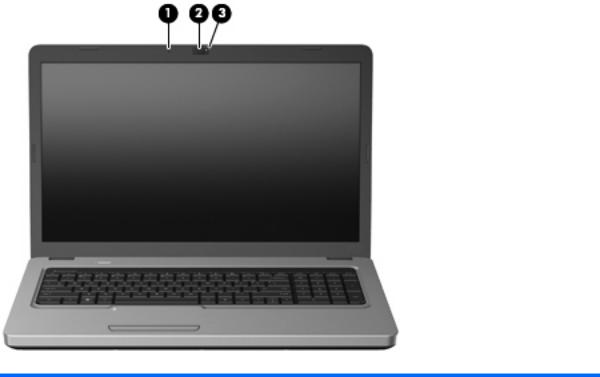
Display components
Component |
Description |
|
|
|
|
(1) |
Internal microphone |
Records sound. |
|
|
|
(2) |
Webcam (select models only) |
Records video and captures still photographs. |
|
|
|
(3) |
Webcam light (select models only) |
On: The webcam is in use. |
|
|
|
Wireless antennas
Your computer model has two antennas that send and receive signals from one or more wireless devices. These antennas are not visible from the outside of the computer.
Components 9
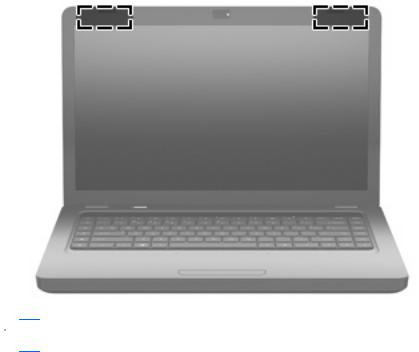
 NOTE: For optimal transmission, keep the areas immediately around the antennas free from obstructions.
NOTE: For optimal transmission, keep the areas immediately around the antennas free from obstructions.
To see wireless regulatory notices, see the section of the Regulatory, Safety and Environmental Notices that applies to your country or region. These notices are located in Help and Support.
10 Chapter 1 Features

Additional hardware components
Component |
Description |
|
|
|
|
(1) |
Power cord* |
Connects an AC adapter to an AC outlet. |
|
|
|
(2) |
AC adapter |
Converts AC power to DC power. |
|
|
|
(3) |
Battery |
Powers the computer when the computer is not plugged into |
|
|
external power. |
*Power cords vary in appearance by country or region.
Components 11
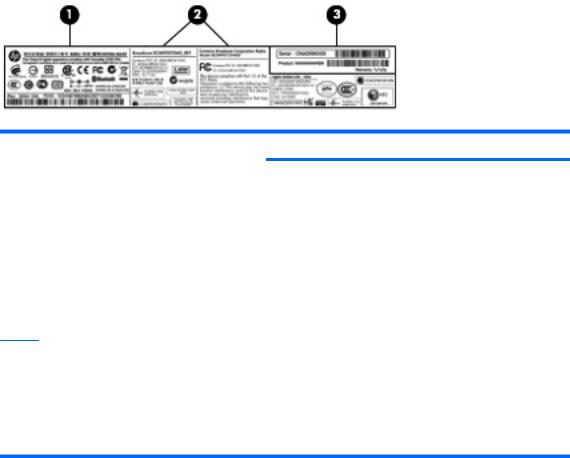
Labels
The labels affixed to the computer provide information you may need when you troubleshoot system problems or travel internationally with the computer.
●Integrated regulatory, wireless certification, and service tag label—Provides regulatory information about the computer, wireless certification information, and the computer model number, serial number, and warranty information. This label is affixed inside the battery bay.
Component
(1) |
Regulatory information |
Provides regulatory information about the computer. |
|
|
|
(2) |
Wireless certification information |
Provides information about optional wireless devices and the |
|
|
approval markings of some of the countries or regions in which |
|
|
the devices have been approved for use. An optional device |
|
|
may be a wireless local area network (WLAN) device or an |
|
|
optional Bluetooth® device. If your computer model includes |
|
|
one or more wireless devices, the certification information is |
|
|
included with your computer. You may need this information |
|
|
when traveling internationally. |
|
|
|
(3) |
Service tag* |
Provides the serial number for this product, as well as the |
|
|
product number and warranty information. |
*Have this information available when you contact technical support:
◦The serial number is an alphanumeric identifier unique to this product.
◦The product number provides specific information about the product's hardware components, which helps a service technician to determine what components and parts are needed.
◦The warranty number describes the duration of the warranty period for this product.
●Microsoft® Certificate of Authenticity—Contains the Windows Product Key. You may need the Product Key to update or troubleshoot the operating system. This certificate is affixed to the bottom of the computer.
●Modem approval label (select models only)—Provides regulatory information about the modem and lists the agency approval markings required by some of the countries or regions in which the modem has been approved for use. You may need this information when traveling internationally. The modem approval label is affixed inside the hard drive bay.
12 Chapter 1 Features

2Wireless, local area network, and modem
Using wireless devices
Wireless technology transfers data across radio waves instead of wires. Your computer may be equipped with one or more of the following wireless devices:
●Wireless local area network (WLAN) device—Connects the computer to wireless local area networks (commonly referred to as Wi-Fi networks, wireless LANs, or WLANs) in corporate offices, your home, and public places such as airports, restaurants, coffee shops, hotels, and universities. In a WLAN, each mobile wireless device communicates with a wireless router or a wireless access point.
●Bluetooth® device (select models only)—Creates a personal area network (PAN) to connect to other Bluetooth-enabled devices such as computers, phones, printers, headsets, speakers, and cameras. In a PAN, each device communicates directly with other devices, and devices must be relatively close together, typically within 10 meters (approximately 33 feet) of each other.
Computers with WLAN devices support one or more of the following IEEE industry standards:
●802.11b, the first popular standard, supports data rates of up to 11 Mbps and operates at a frequency of 2.4 GHz.
●802.11g supports data rates of up to 54 Mbps and operates at a frequency of 2.4 GHz. An 802.11g WLAN device is backward compatible with 802.11b devices, so they can operate on the same network.
●802.11a supports data rates of up to 54 Mbps and operates at a frequency of 5 GHz.
 NOTE: 802.11a is not compatible with 802.11b and 802.11g.
NOTE: 802.11a is not compatible with 802.11b and 802.11g.
●802.11n supports data rates of up to 450 Mbps and may operate at 2.4 GHz or 5 GHz, making it backward compatible with 802.11a, b, and g.
For more information on wireless technology, see the information and Web site links provided in Help and Support.
Using wireless devices 13

Identifying wireless and network status icons
Icon |
Name |
Description |
|
|
|
|
Wireless (connected) |
Identifies the location of the wireless light and the wireless action |
|
|
key (f12) on the computer. Also identifies the HP Wireless Assistant |
|
|
software on the computer and indicates that one or more of the |
|
|
wireless devices are on. |
|
|
|
|
Wireless (disconnected) |
Identifies the HP Wireless Assistant software on the computer and |
|
|
indicates that all of the wireless devices are off. |
|
|
|
|
Wired network (connected) |
Indicates that one or more network drivers are installed, and one or |
|
|
more network devices are connected to a wired network. |
|
|
|
|
Wired network (disabled/ |
Indicates that one or more network drivers are installed, but no |
|
disconnected) |
network devices are connected (or all network devices are disabled |
|
|
in Windows Control Panel). |
|
|
|
|
Network (connected) |
Indicates that one or more network drivers are installed, and one or |
|
|
more network devices are connected to a wireless network. |
|
|
|
|
Network (disconnected) |
Indicates that one or more network drivers are installed and wireless |
|
|
connections are available, but no network devices are connected to |
|
|
a wireless network. |
|
|
|
|
Network (disabled/ |
Indicates that one or more network drivers are installed, but no |
|
disconnected) |
wireless connections are available (or all wireless network devices |
|
|
are turned off by the wireless action key [f12] or HP Wireless |
|
|
Assistant). |
|
|
|
Using the wireless controls
You can control the wireless devices in your computer using these features:
●The wireless action key (f12)
●HP Wireless Assistant software
●Operating system controls
Using the wireless action key
The computer has a wireless action key (f12), one or more wireless devices, and a wireless light. All of the wireless devices on your computer are enabled at the factory, so the wireless light is on (white) when you turn on the computer.
The wireless light indicates the overall power state of your wireless devices, not the status of individual devices. If the wireless light is white, at least one wireless device is on. If the wireless light is amber, all wireless devices are off.
Because the wireless devices are enabled at the factory, you can use the wireless action key (f12) to turn on or turn off all of the wireless devices simultaneously. Individual wireless devices can be controlled through HP Wireless Assistant.
14 Chapter 2 Wireless, local area network, and modem

Using HP Wireless Assistant
A wireless device can be turned on or off using HP Wireless Assistant. If a wireless device is disabled in Setup Utility, it must be reenabled in Setup Utility before it can be turned on or off using Wireless Assistant.
 NOTE: Enabling or turning on a wireless device does not automatically connect the computer to a network or a Bluetooth-enabled device.
NOTE: Enabling or turning on a wireless device does not automatically connect the computer to a network or a Bluetooth-enabled device.
To view the state of the wireless devices, click the Show hidden icons icon, the arrow at the left of the notification area, and then position the mouse pointer over the wireless icon.
If the wireless icon is not displayed in the notification area, complete the following steps to change Wireless Assistant properties:
1.Select Start > Control Panel > Hardware and Sound > Windows Mobility Center.
2.Click the wireless icon in the Wireless Assistant tile, which is located in the bottom row of Windows Mobility Center. Wireless Assistant opens.
3.Click Properties.
4.Select the check box next to HP Wireless Assistant icon in notification area.
5.Click Apply.
6.Click Close.
For more information, see the Wireless Assistant software Help:
1.Open Wireless Assistant by clicking the wireless icon in Windows Mobility Center.
2.Click the Help button.
Using operating system controls
Some operating systems also offer a way to manage integrated wireless devices and the wireless connection. For example, Windows provides the Network and Sharing Center that allows you to set up a connection or network, connect to a network, manage wireless networks, and diagnose and repair network problems.
To access the Network and Sharing Center, select Start > Control Panel > Network and Internet > Network and Sharing Center.
For more information, select Start > Help and Support.
Using wireless devices 15

Using a WLAN
With a WLAN device, you can access a wireless local area network (WLAN), which is composed of other computers and accessories that are linked by a wireless router or a wireless access point.
 NOTE: The terms wireless router and wireless access point are often used interchangeably.
NOTE: The terms wireless router and wireless access point are often used interchangeably.
●A large-scale WLAN, such as a corporate or public WLAN, typically uses wireless access points that can accommodate a large number of computers and accessories and can separate critical network functions.
●A home or small office WLAN typically uses a wireless router, which allows several wireless and wired computers to share an Internet connection, a printer, and files without requiring additional pieces of hardware or software.
To use the WLAN device in your computer, you must connect to a WLAN infrastructure (provided through a service provider or a public or corporate network).
Setting up a WLAN
To set up a WLAN and connect to the Internet, you need the following equipment:
●A broadband modem (either DSL or cable) (1) and high-speed Internet service purchased from an Internet service provider (ISP)
●A wireless router (purchased separately) (2)
●The wireless computer (3)
The illustration below shows an example of a wireless network installation that is connected to the Internet.
As your network grows, additional wireless and wired computers can be connected to the network to access the Internet.
For help in setting up your WLAN, see the information provided by your router manufacturer or your ISP.
16 Chapter 2 Wireless, local area network, and modem
Protecting your WLAN
Because the WLAN standard was designed with only limited security capabilities—basically to foil casual eavesdropping rather than more powerful forms of attack—it is essential to understand that WLANs are vulnerable to well-known and well-documented security weaknesses.
WLANs in public areas, or “hotspots,” like coffee shops and airports may not provide any security. New technologies are being developed by wireless manufacturers and hotspot service providers that make the public environment more secure and anonymous. If you are concerned about the security of your computer in a hotspot, limit your network activities to noncritical e-mail and basic Internet surfing.
When you set up a WLAN or access an existing WLAN, always enable security features to protect your network from unauthorized access. The common security levels are Wi-Fi Protected Access (WPA)- Personal and Wired Equivalent Privacy (WEP). Because wireless radio signals travel outside the network, other WLAN devices can pick up unprotected signals and either connect to your network (uninvited) or capture information being sent across it. However, you can take precautions to protect your WLAN:
●Use a wireless transmitter with built-in security
Many wireless base stations, gateways, or routers provide built-in security features such as wireless security protocols and firewalls. With the correct wireless transmitter, you can protect your network from the most common wireless security risks.
●Work behind a firewall
A firewall is a barrier that checks both data and requests for data that are sent to your network, and discards any suspicious items. Firewalls are available in many varieties, both software and hardware. Some networks use a combination of both types.
●Use wireless encryption
A variety of sophisticated encryption protocols are available for your WLAN:
◦Wired Equivalent Privacy (WEP) is a wireless security protocol that encodes or encrypts all network data before it is transmitted using a WEP key. Usually, you can allow the network to assign the WEP key. Alternatively, you can set up your own key, generate a different key, or choose other advanced options. Without the correct key, others will not be able to use the WLAN.
◦WPA (Wi-Fi Protected Access), like WEP, uses security settings to encrypt and decrypt data that is transmitted over the network. However, instead of using one static security key for encryptions as WEP does, WPA uses “temporal key integrity protocol” (TKIP) to dynamically generate a new key for every packet. It also generates different sets of keys for each computer on the network.
Using a WLAN 17

Connecting to a WLAN
To connect to the WLAN, follow these steps:
1.Be sure that the WLAN device is on (the wireless light is white). If the wireless light is amber, press the wireless action key (f12).
2.Click the network icon in the notification area, at the far right of the taskbar.
3.Select your WLAN from the list.
4.Click Connect.
If the network is a security-enabled WLAN, you are prompted to enter a network security key, which is a security code. Enter the code, and then click OK to complete the connection.
 NOTE: If no WLANs are listed, you are out of range of a wireless router or access point.
NOTE: If no WLANs are listed, you are out of range of a wireless router or access point.
NOTE: If you do not see the network you want to connect to, click Open Network and Sharing Center, and then click Set up a new connection or network. A list of options is displayed. You can choose to manually search for and connect to a network or to create a new network connection.
After the connection is made, place the mouse pointer over the network icon in the notification area, at the far right of the taskbar, to verify the name and status of the connection.
 NOTE: The functional range (how far your wireless signals travel) depends on WLAN implementation, router manufacturer, and interference from other electronic devices or structural barriers such as walls and floors.
NOTE: The functional range (how far your wireless signals travel) depends on WLAN implementation, router manufacturer, and interference from other electronic devices or structural barriers such as walls and floors.
More information about using a WLAN is available through the following resources:
●Information from your ISP and the user guides included with your wireless router and other WLAN equipment
●Information and Web site links provided in Help and Support
For a list of public WLANs near you, contact your ISP or search the web. Web sites that list public WLANs include Cisco Internet Mobile Office Wireless Locations, Hotspotlist, and Geektools. Check with each public WLAN location for cost and connection requirements.
Roaming to another network
When you move your computer within range of another WLAN, Windows attempts to connect to that network. If the attempt is successful, your computer is automatically connected to the new network. If Windows does not recognize the new network, follow the same procedure you used initially to connect to your WLAN.
18 Chapter 2 Wireless, local area network, and modem
Using Bluetooth wireless devices (select models only)
A Bluetooth device provides short-range wireless communications that replace the physical cable connections that traditionally link electronic devices such as the following:
●Computers (desktop, notebook, PDA)
●Phones (cellular, cordless, smart phone)
●Imaging devices (printer, camera)
●Audio devices (headset, speakers)
Bluetooth devices provide peer-to-peer capability that allows you to set up a personal area network (PAN) of Bluetooth devices. For information on configuring and using Bluetooth devices, see the Bluetooth software Help.
Bluetooth and Internet Connection Sharing (ICS)
HP does not recommend setting up one computer with Bluetooth as a host and using it as a gateway through which other computers may connect to the Internet. When two or more computers are connected using Bluetooth, and Internet Connection Sharing (ICS) is enabled on one of the computers, the other computers may not be able to connect to the Internet using the Bluetooth network.
The strength of Bluetooth is in synchronizing information transfers between your computer and wireless devices including cellular phones, printers, cameras, and PDAs. The inability to consistently connect two or more computers to share the Internet through Bluetooth is a limitation of Bluetooth and the Windows operating system.
Using Bluetooth wireless devices (select models only) 19

Troubleshooting wireless connection problems
Some possible causes for wireless connection problems include the following:
●Network configuration (SSID or security) has been changed.
●Wireless device is not installed correctly or has been disabled.
●Wireless device or router hardware has failed.
●Wireless device encountered interference from other devices.
 NOTE: Wireless networking devices are included with select computer models only. If wireless networking is not listed in the feature list on the side of the original computer package, you may add wireless networking capability to the computer by purchasing a wireless networking device.
NOTE: Wireless networking devices are included with select computer models only. If wireless networking is not listed in the feature list on the side of the original computer package, you may add wireless networking capability to the computer by purchasing a wireless networking device.
Before working your way through the sequence of possible solutions to your network connection problem, be sure that device drivers are installed for all wireless devices.
Use the procedures in this chapter to diagnose and repair a computer that does not connect to the network you want to use.
Cannot connect to a WLAN
If you have a problem connecting to a WLAN, confirm that the integrated WLAN device is properly installed on your computer:
 NOTE: Windows includes the User Account Control feature to improve the security of your computer. You may be prompted for your permission or password for tasks such as installing software, running utilities, or changing Windows settings. See Help and Support for more information.
NOTE: Windows includes the User Account Control feature to improve the security of your computer. You may be prompted for your permission or password for tasks such as installing software, running utilities, or changing Windows settings. See Help and Support for more information.
1.Select Start > Control Panel > System and Security.
2.In the System area, click Device Manager.
3.Click the arrow next to Network adapters to expand the list and show all adapters.
4.Identify the WLAN device from the Network adapters list. The listing for a WLAN device may include the term wireless, wireless LAN, WLAN, Wi-Fi, or 802.11.
If no WLAN device is listed, either your computer does not have an integrated WLAN device, or the driver for the WLAN device is not properly installed.
For more information on troubleshooting WLANs, see the Web site links provided in Help and Support.
Cannot connect to a preferred network
Windows can automatically repair a corrupted WLAN connection:
●If there is a network icon in the notification area, at the far right of the taskbar, right-click the icon, and then click Troubleshoot problems.
Windows resets your network device and attempts to reconnect to one of the preferred networks.
●If there is no network icon in the notification area, follow these steps:
1.Select Start > Control Panel > Network and Internet > Network and Sharing Center.
2.Click Troubleshoot problems, and then select the network you wish to repair.
20 Chapter 2 Wireless, local area network, and modem
